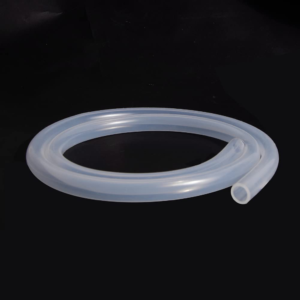Food safe tubing finds numerous applications in food processing and packaging due to its ability to maintain hygiene and ensure the safety of food products.
Here are some potential applications of food safe tubing in the food industry:
Transfer of Liquids: Food safe tubing is commonly used for the transfer of liquids such as water, juices, milk, sauces, oils, and beverages during food processing. It provides a safe and hygienic conduit for the movement of fluids between different stages of production.
Conveyance of Gases: Food safe tubing is utilized for the conveyance of gases like compressed air, nitrogen, and carbon dioxide in food processing operations. It is crucial for processes such as carbonation, packaging, and modified atmosphere packaging (MAP).
Pumping Systems: Food safe tubing is employed in pumping systems for the movement of food ingredients, additives, and flavorings. It ensures the cleanliness and purity of the substances being pumped, preventing contamination.
Filling and Packaging: Food safe tubing is used in filling and packaging applications, where it enables the precise and controlled filling of food products into containers. It is commonly found in liquid filling machines, ensuring the hygienic transfer of products to packaging units.
Dairy and Cheese Production: Food safe tubing is extensively utilized in dairy and cheese production processes. It facilitates the transportation of milk, cream, yogurt, and other dairy products, ensuring their integrity and quality.
Brewing and Beverage Industry: Food safe tubing is employed in breweries and beverage production facilities for the transfer of ingredients, wort, beer, and other beverages. It plays a crucial role in maintaining the hygiene and quality of the products.
Confectionery and Chocolate Manufacturing: Food safe tubing is used in confectionery and chocolate manufacturing processes for the transportation of liquid chocolate, fillings, syrups, and coatings. It ensures the cleanliness and purity of these ingredients.
Sauce and Condiment Production: Food safe tubing is utilized in the production of sauces, condiments, and dressings, allowing the controlled flow and transfer of these products without contamination.
Meat Processing: Food safe tubing is employed in meat processing for the transportation of liquids, marinades, brines, and flavorings. It helps maintain the safety and quality of meat products.
Clean-in-Place (CIP) Systems: Food safe tubing is integrated into Clean-in-Place systems to facilitate the thorough cleaning and sanitization of processing equipment and pipelines. It enables the circulation of cleaning solutions and rinses, ensuring effective hygiene practices.
These are just a few examples of the varied applications of food safe tubing in the food processing and packaging industry. Its hygienic properties, flexibility, and compatibility with food products make it an essential component in ensuring food safety and quality.
How does food safe tubing ensure the safety and hygiene of food products?
Food safe tubing is designed and manufactured with specific properties and features that contribute to ensuring the safety and hygiene of food products.
Here are some ways in which food safe tubing accomplishes this:
Food-Grade Materials: Food safe tubing is made from materials that are approved for contact with food and comply with relevant food safety regulations. Common materials include FDA-approved plastics such as PVC (polyvinyl chloride), silicone, and polyethylene. These materials are non-toxic, non-reactive, and do not impart any harmful substances to the food.
Hygienic Construction: Food safe tubing is constructed in a manner that minimizes the chances of contamination. It is designed to have smooth, non-porous surfaces that are easy to clean and prevent the buildup of bacteria or other microorganisms. China food safe tubing The absence of crevices or seams reduces the risk of bacterial growth and allows for thorough cleaning.
Resistance to Chemicals: Food safe tubing is resistant to a wide range of chemicals, including cleaning agents and sanitizers commonly used in the food industry. This resistance ensures that the tubing material remains intact and does not leach harmful substances into the food product.
High Cleanliness Standards: Food safe tubing is manufactured under strict cleanliness standards to minimize the presence of particles, residues, or impurities that could contaminate the food. It undergoes thorough cleaning and quality control processes to ensure its suitability for food contact.
Temperature Resistance: Food safe tubing is designed to withstand the temperature extremes encountered in food processing, such as hot liquids or steam during cleaning and high-temperature cooking processes. This resistance to temperature ensures the tubing’s structural integrity and prevents any degradation or leaching of materials into the food.
Compatibility with Sanitary Fittings: Food safe tubing is designed to be compatible with sanitary fittings and connections commonly used in the food industry. These fittings ensure a secure and hygienic connection, minimizing the risk of leaks or contamination during food processing.
Regulatory Compliance: Food safe tubing is manufactured in compliance with food safety regulations and guidelines, such as those set by the U.S. Food and Drug Administration (FDA) and international standards organizations. Compliance with these regulations ensures that the tubing meets specific requirements for food contact materials.
By incorporating these features and adhering to strict manufacturing standards, food safe tubing provides a reliable and hygienic conduit for the transportation, processing, and packaging of food products. It helps prevent contamination, maintains food safety, and upholds the quality and integrity of the food throughout the production process.
